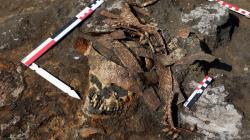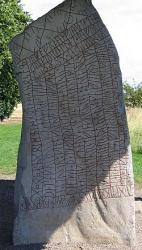ONLINE COURSES / COURS A DISTANCE
SUMMER TERM : JANUARY 2020
REGISTER NOW
RUSSIE -  Moscou - Archaeologists have stumbled upon a rare discovery during excavations in downtown Moscow, finding shards of molded ceramic vessels decorated with ornaments characteristic of later stages of the Neolithic period’s Lyalovo culture (4,000-3,000 BC). The fascinating relics of the past unearthed on the grounds of the former Moscow Orphanage reveal that a campsite inhabited by ancient fishermen could have existed there, the press service for Moscow’s Department of Cultural Heritage told TASS on Thursday. "The discovered ceramic pieces can indicate that a camp of ancient fishermen could have been here long ago. Experts are now looking into this theory," the press service quoted the department’s head Alexei Yemelyanov as saying. It is pointed out that the fragments were discovered in sedimentary layers formed in repeated Moskva River overflows. "It is premature to make judgements whether the materials are of local decent or were washed ashore by the water," the press service added.
Moscou - Archaeologists have stumbled upon a rare discovery during excavations in downtown Moscow, finding shards of molded ceramic vessels decorated with ornaments characteristic of later stages of the Neolithic period’s Lyalovo culture (4,000-3,000 BC). The fascinating relics of the past unearthed on the grounds of the former Moscow Orphanage reveal that a campsite inhabited by ancient fishermen could have existed there, the press service for Moscow’s Department of Cultural Heritage told TASS on Thursday. "The discovered ceramic pieces can indicate that a camp of ancient fishermen could have been here long ago. Experts are now looking into this theory," the press service quoted the department’s head Alexei Yemelyanov as saying. It is pointed out that the fragments were discovered in sedimentary layers formed in repeated Moskva River overflows. "It is premature to make judgements whether the materials are of local decent or were washed ashore by the water," the press service added.
https://tass.com/society/1106937
RUSSIE –  Devitsa - For the first time, remains of these ancient Siberian soldiers have been found in the same tomb. This is the 11th find at the Cemetery Devitsa site, and they seem to have been garrison troops at the camp while others were off fighting. And they fought a lot, they dominated the Pontic steppe for 400 years, until the Macedonians began to push them back and then Mithridates of Persia finished the job. The remains were estimated to have been buried sometime during the 4th century B.C. This village cemetery, located in a plowed field, has been investigated since 2010 and the tomb was under a three-foot-tall, 120-foot mound covered in oak blocks. Estimates of ages vary but the youngest were probably an early teen while the oldest was in her 40s. The eldest had a calathos headdress decorated with pendants of gold, copper, silver and iron. Why were they all buried together? It's a mystery, but military logic suggests the camp did get attacked and they perished in the fighting.
Devitsa - For the first time, remains of these ancient Siberian soldiers have been found in the same tomb. This is the 11th find at the Cemetery Devitsa site, and they seem to have been garrison troops at the camp while others were off fighting. And they fought a lot, they dominated the Pontic steppe for 400 years, until the Macedonians began to push them back and then Mithridates of Persia finished the job. The remains were estimated to have been buried sometime during the 4th century B.C. This village cemetery, located in a plowed field, has been investigated since 2010 and the tomb was under a three-foot-tall, 120-foot mound covered in oak blocks. Estimates of ages vary but the youngest were probably an early teen while the oldest was in her 40s. The eldest had a calathos headdress decorated with pendants of gold, copper, silver and iron. Why were they all buried together? It's a mystery, but military logic suggests the camp did get attacked and they perished in the fighting.
https://www.science20.com/content/mass_amazonian_warrior_grave_discovered_in_russia
SUEDE –  Rök - The Rök runestone from central middle Sweden, dated to around 800 CE, is famous, among other things, for a supposed reference to the emperor Theodoric the Great. This study proposes instead that the inscription deals with an anxiety triggered by a son’s death and the fear of a new climate crisis similar to the catastrophic one after 536 CE. Combining perspectives and findings from semiotics, philology, archaeology, and history of religion, the study presents a completely new interpretation which follows a unified theme, showing how the monument can be understood in the socio-cultural and religious context of early Viking Age Scandinavia. The inscription consists, according to the proposed interpretation, of nine enigmatic questions. Five of the questions concern the sun, and four of them, it is argued, ask about issues related to the god Odin. A central finding is that there are relevant parallels to the inscription in early Scandinavian poetry, especially in the Eddic poem Vafþrúðnismál.
Rök - The Rök runestone from central middle Sweden, dated to around 800 CE, is famous, among other things, for a supposed reference to the emperor Theodoric the Great. This study proposes instead that the inscription deals with an anxiety triggered by a son’s death and the fear of a new climate crisis similar to the catastrophic one after 536 CE. Combining perspectives and findings from semiotics, philology, archaeology, and history of religion, the study presents a completely new interpretation which follows a unified theme, showing how the monument can be understood in the socio-cultural and religious context of early Viking Age Scandinavia. The inscription consists, according to the proposed interpretation, of nine enigmatic questions. Five of the questions concern the sun, and four of them, it is argued, ask about issues related to the god Odin. A central finding is that there are relevant parallels to the inscription in early Scandinavian poetry, especially in the Eddic poem Vafþrúðnismál.
http://uu.diva-portal.org/smash/record.jsf?pid=diva2%3A1383036&dswid=7245
U.A.E. -  Saruq Al Hadid - Archaeologists have discovered evidence that ancient people living in the area of what is now Dubai practiced recycling methods around 3,000 years ago. A team of researchers found around 2,600 copper, bronze and iron objects at Saruq Al Hadid in the Persian Gulf that incorporated broken parts from ceramic vessels. "It is an interesting fact that a few thousand years ago, the inhabitants of this place implemented recycling. Broken ceramic vessels were not thrown away, instead they were only slightly modified and used as tools," Karol Juchniewicz, head of the research from ArcheoConsultant, told Science in Poland. "They included weapons, decorations, jewelry and iconic or magical items, for example figurines of snakes," Juchniewicz said. Previous research has revealed that people had been making metal objects at Saruq Al Hadid since around 4,000 years ago. It was discovered in 2002 by the ruler of Dubai Sheik Mohammad bin Rashid al Maktoum while he was flying in his helicopter above the Rub al-Khali desert. The ruler noticed that the pattern of the sand dunes in one area of the desert took an unusual form. In addition, he observed that numerous black stones were dotted between the dunes. The sheik reported the sightings to scientists, who discovered that the stones were made from slag—a by-product in the metal smelting process. According to researchers, the large number of black slag stones indicates that the production of metal at the site took place on a huge scale. But despite being in the middle of a desert, in ancient times, the area may have been home to an oasis with abundant vegetation—and even lakes. "This is the only explanation for the location of metal production furnaces in a place that is today an endless desert," Juchniewicz said. Additional research is being conducted at the site in an attempt to reveal more of its hidden secrets. Saruq Al Hadid is one of the most important Iron Age sites in the United Arab Emirates, and indeed the entire Arabian Peninsula. Experts say it was once a significant center for trade and metallurgy, which flourished between around 1,100 B.C. and 600 B.C.
Saruq Al Hadid - Archaeologists have discovered evidence that ancient people living in the area of what is now Dubai practiced recycling methods around 3,000 years ago. A team of researchers found around 2,600 copper, bronze and iron objects at Saruq Al Hadid in the Persian Gulf that incorporated broken parts from ceramic vessels. "It is an interesting fact that a few thousand years ago, the inhabitants of this place implemented recycling. Broken ceramic vessels were not thrown away, instead they were only slightly modified and used as tools," Karol Juchniewicz, head of the research from ArcheoConsultant, told Science in Poland. "They included weapons, decorations, jewelry and iconic or magical items, for example figurines of snakes," Juchniewicz said. Previous research has revealed that people had been making metal objects at Saruq Al Hadid since around 4,000 years ago. It was discovered in 2002 by the ruler of Dubai Sheik Mohammad bin Rashid al Maktoum while he was flying in his helicopter above the Rub al-Khali desert. The ruler noticed that the pattern of the sand dunes in one area of the desert took an unusual form. In addition, he observed that numerous black stones were dotted between the dunes. The sheik reported the sightings to scientists, who discovered that the stones were made from slag—a by-product in the metal smelting process. According to researchers, the large number of black slag stones indicates that the production of metal at the site took place on a huge scale. But despite being in the middle of a desert, in ancient times, the area may have been home to an oasis with abundant vegetation—and even lakes. "This is the only explanation for the location of metal production furnaces in a place that is today an endless desert," Juchniewicz said. Additional research is being conducted at the site in an attempt to reveal more of its hidden secrets. Saruq Al Hadid is one of the most important Iron Age sites in the United Arab Emirates, and indeed the entire Arabian Peninsula. Experts say it was once a significant center for trade and metallurgy, which flourished between around 1,100 B.C. and 600 B.C.
https://www.newsweek.com/evidence-recycling-3000-years-ago-ancient-civilization-middle-east-1481333?piano_t=1